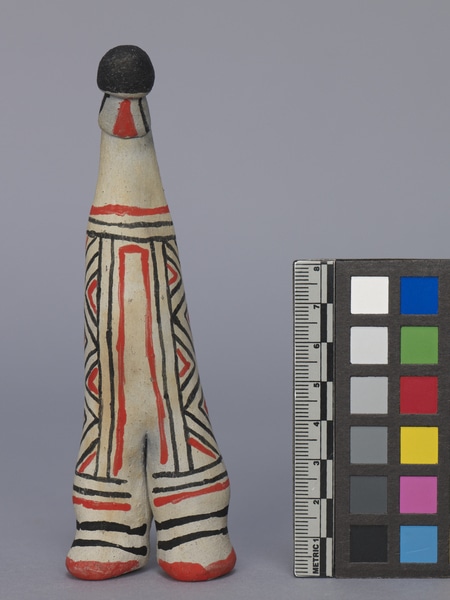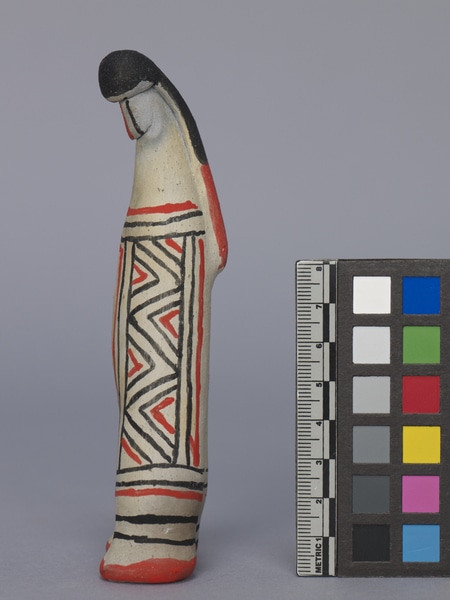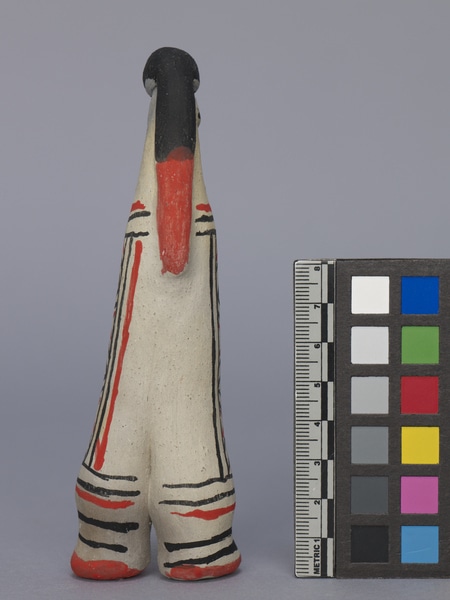Figure Item Number: 3175/2 from the MOA: University of British Columbia




Description
Ceramic ritxoko doll. Figure takes the basic shape of a standing person, with thick legs on large rounded feet, a long torso and neck, and a small face painted black and orange. Thick, heavy hair in black and orange sits on the head and falls in a tail down the back of the figure. Surface is painted with orange and black lines, with several sets of concentric triangles along the sides.
History Of Use
The Iny (formerly known as Karajá) are known for their ceramics. Only elder women make ritxoko clay dolls, which are now an important source of income as well as a source of subjective and symbolic inspiration to redress the wounds of violent colonial occupation. Iny society is organized around extended families of three or four generations. There is a deep divide between male and female practices. As they approach puberty, young girls are offered a set of ritxoko clay dolls to play with. These represent a family and include both boys and girls of various ages. Contemporary production includes both modern and old styles. The modern style is more realistic while the old style is less complex technically, with the arms placed close to the body in female figures, for instance, and signified only by shoulders in male figures. Both old and modern painting styles are highly conventional and replicate the complex body painting the Iny use to signify status from cradle to grave. The Karajá dolls "Ritxòkò" were declared intangible cultural heritage of Brazil in 2012.
Specific Techniques
Black pigment is created by mixing jenipapo fruit (Genipa americana) with coal, and red from the seeds of the shrub urucum (Bixa orellana).
Cultural Context
When the various Iny groups were first contacted by Europeans in the 18th century their total population was estimated to be around 9,000. Persecution and slavery led to a precipitous decline, and by the early 20th century less than 600 individuals were left, facing possible extinction. As part of the “developmental” policies of successive Brazilian governments, their lands were occupied by cattle grazers and industrial farmers, and their rivers exploited for commercial fishing. But against the odds the Iny have prospered, and by 2014 their population had rebounded to about 4,000 people.
Iconographic Meaning
This figure represents a single man, highlighting his status as a bachelor rather than his age.
Item History
- Made in Ilha do Bananal, Tocantins, Brazil during 2016
- Owned by Museu Antropologico da UFG before May 31, 2016
- Received from Museu Antropologico da UFG (Donor) on May 31, 2016
What
Who
- Culture
- Iny
- Previous Owner
- Museu Antropologico da UFG
- Received from
- Museu Antropologico da UFG (Donor)
Where
- Holding Institution
- MOA: University of British Columbia
- Made in
- Ilha do Bananal, Tocantins, Brazil
When
- Creation Date
- during 2016
- Ownership Date
- before May 31, 2016
- Acquisition Date
- on May 31, 2016
Other
- Item Classes
- ceramics
- Condition
- excellent
- Accession Number
- 3175/0002